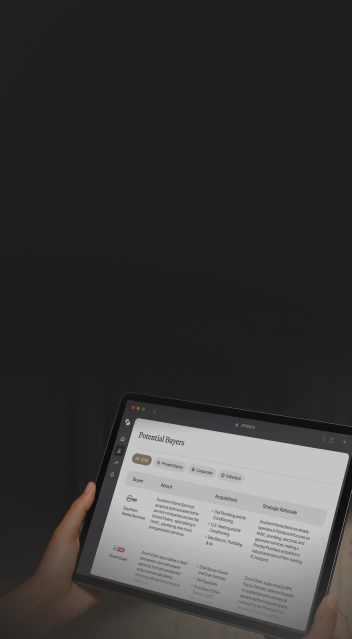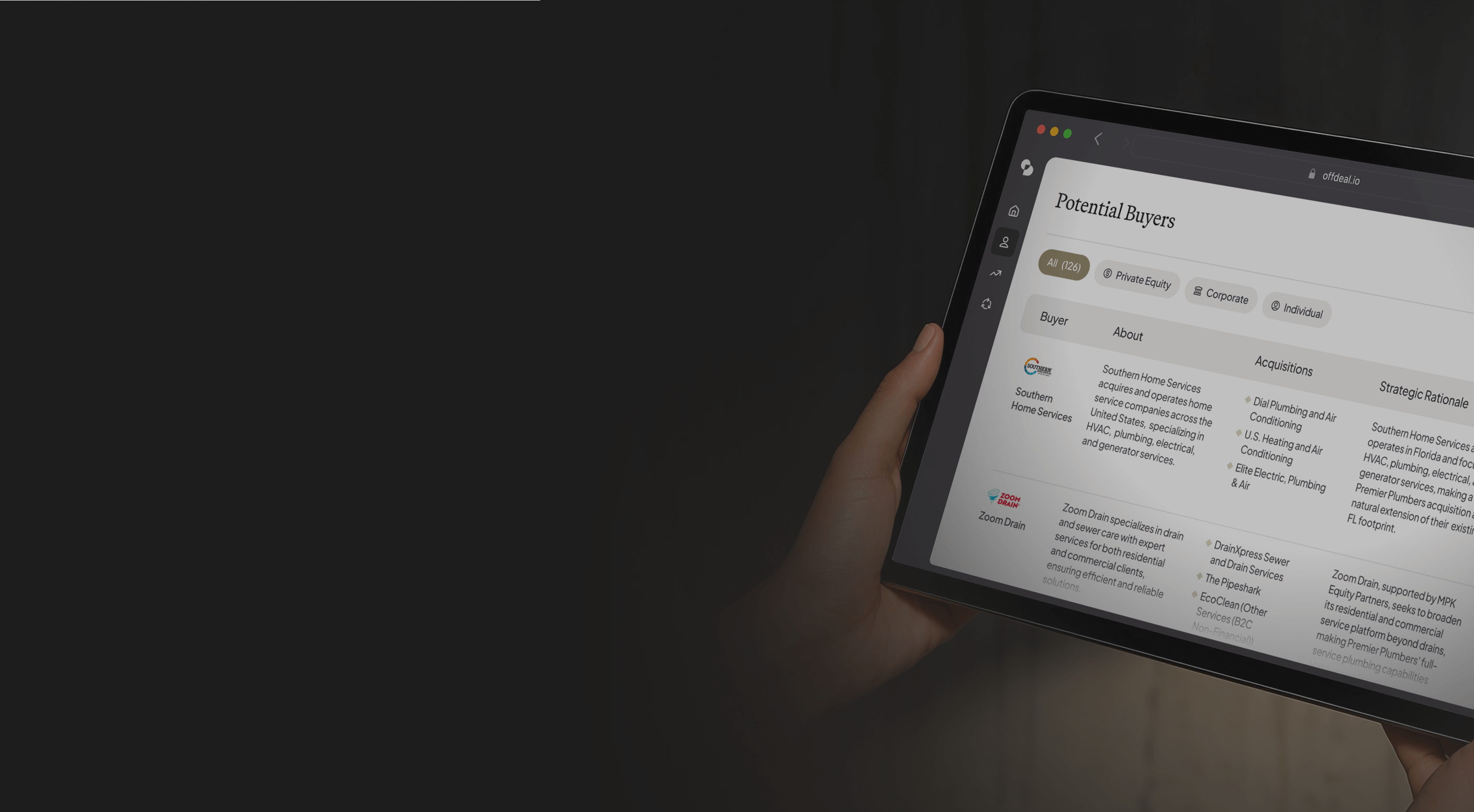Article
February 5, 2025
A Guide to Seller's Discretionary Earnings: For Business Owners
Learn how to calculate seller's discretionary earnings with this guide for business owners. Boost your sale value today!

Table of Contents
As a small business owner, you probably know what your business does in sales or what you reported in profit on your last tax return. You might even have a good handle on your EBITDA. But here's what most owners don't realize: if you operate a smaller business (less than $5M in revenue), focusing on EBITDA alone could dramatically underrepresent your actual profitability to prospective buyers.
This knowledge gap leads many owners to make costly mistakes when selling:
Undervaluing their business by focusing only on reported profits or EBITDA
Missing legitimate add-backs that could increase their sale price by 50% or more
Failing to document personal benefits that buyers would pay extra for
In this article, you'll learn:
What SDE is and why it's the key metric for small business sales
How to calculate your SDE from your financial statements
Which personal benefits and expenses can legitimately increase your SDE
How to use SDE to estimate your business's market value
How to increase your SDE (and therefore your sale price)
Understanding SDE
SDE (Seller's Discretionary Earnings) reveals the total financial benefit and earnings a full-time owner gets from their business. Think of it as "owner benefit" – all the money a new owner could potentially take home, whether it shows up on your tax return or not.
Let's look at a real example of why this matters:
| Metric | Auto Shop A | Auto Shop B |
|---|---|---|
| Reported Profit | $100K | $100K |
| Owner's Salary | $150K | $200k |
| Spouse's Salary | -- | $70K |
| Personal Vehicle | -- | $30K |
| Family Health Insurance | $25K | $30K |
| Other Personal Expenses | $10K | $40K |
| True SDE | $285K | $470K |
| Likely Sale Price* | $1.14M | $1.88M |
Note: Based on a typical 4x SDE multiple
Despite showing identical profits, Auto Shop B is worth $740,000 more because the owner runs more legitimate personal expenses through the business – all of which can be added back to calculate true SDE.
💡 Quick Tip: Your business could be worth twice what you think once you properly calculate SDE. This is why getting this number right is crucial when selling.
How to Calculate Your SDE
Let's break down the calculation step by step:
Start with Net Profit
Add back EBITDA adjustments (interest, taxes, depreciation, amortization)
Add back owner-specific benefits and one-time / non-recurring items
Here's how this might look in practice:
| Category | Amount | Explanation |
|---|---|---|
| Net Profit | $100,000 | Starting point |
| EBITDA Adjustment | ||
| + Internet | $30,000 | Business loans |
| + Taxes | $40,000 | Income taxes |
| + Depreciation | $50,000 | Equipment |
| = EBDITA | $220,000 | |
| Owners Adjustments: | ||
| + Owner's Salary | $180,000 | Full compensation |
| + Spouse's Wages | $60,000 | Non-working family |
| + Personal Vehicle | $25,000 | Two cars |
| + Health Insurance | $30,000 | Family coverage |
| + One-time Legal | $35,000 | Lawsuit defense |
| = Final SDE | $550,000 | True owner benefit |
What Qualifies as a Legitimate Add-back?
There are two main types of SDE adjustments:
Owner benefit add-backs - personal expenses that you might run through the business
One-time benefit/cost add-backs - items that will not continue under new ownership
| Owner Benefit Add-backs | One-time items |
|---|---|
| • Owner's salary and benefits • Family member wages • Personal vehicles • Health/life insurance • Travel & entertainment | • Legal fees from a lawsuit • Equipment upgrade • Office relocation expenses • Website redesign • Start-up costs |
⚠️ Warning: Keep clear documentation of all additional expenses and add-backs. Buyers will scrutinize every dollar during due diligence.
Using SDE to Value Your Business
Once you have calculated your business’s SDE, you can use it to arrive at an approximate valuation for your business by multiplying that figure by the appropriate business valuation multiplier.
Figuring out the right multiple for your business can be challenging (here is an article that explains how to do it). But as a general rule of thumb, small businesses typically sell for 2-5 times SDE, though multiples can vary significantly based on several factors:
| Factor | Lower Multiple | Higher Multiple |
|---|---|---|
| Revenue Type | Project based | Recurring contracts |
| Customer Base | High concentration | Well-diversified |
| Growth Rate | Flat or declining | Consistent growth |
| Owner Involvement | Heavy dependence on owner | Business can run without the owner |
| Financial Records | Poor documentation | Clean and up to date books |
Let's see how these factors impact real-world valuations:
| Characteristic | Landscape Co. A | Landscape Co. B |
|---|---|---|
| Annual SDE | $400K | $400K |
| Revenue Type | 80% maintenance contracts | 90% one-time projects |
| Customer Base | No client over 3% | Top 3 = 50% of revenue |
| Owner involvement | Capable management team in place | Owner runs everything |
| Documentation | Books prepared by a CPA | Basic record keeping in Quickbooks |
| Multiple | 4.5x | 2.0x |
| Value | $1.8M | $800K |
💡Quick Tip: An experienced M&A advisor will be able to give you a better estimate of what your business is worth based on their data on past similar transactions, as well as their deep understanding of how buyers view and assess acquisition opportunities in your industry.
Practical Steps to Improve Your SDE
Improving and tracking your SDE doesn’t have to be complicated. By implementing a few straightforward practices, you can consistently monitor your business’s operational profitability and set yourself up for long-term success.
Make these steps part of your routine to track and improve SDE consistently:
Calculate and Track Your SDE Quarterly:
Pull your profit and loss (P&L) statement.
Calculate your SDE by adding back personal and one-time expenses
Compare results with previous quarters to identify trends and areas for improvement.
Grow Your SDE:
Optimize pricing strategies (experiment with price increases for high-demand or premium offerings
Identify opportunities for cross-selling to your existing customers
Streamline operations where possible and invest in automation of manual processes
Negotiate discounts from vendors
Document Everything:
Track all owner benefits
Save receipts for personal expenses
Note any unusual or one-time costs
Conclusion: Know and Grow Your SDE
Understanding and optimizing your SDE isn't just about better business metrics – it's about maximizing the value of your life's work. Every $10,000 improvement in SDE could add $20,000-$50,000 to your final sale price. This is real money in your pocket when you finally decide to realize the value you've built.
Summary:
SDE, not tax return profit, determines your business's true value
Personal expenses and benefits can legitimately increase your SDE
Clean books and good documentation are crucial for credibility
Industry and business characteristics determine your final multiple
Every improvement in SDE directly increases your sale price
Next Steps
Whether you’re just starting to explore your exit options or ready to meet potential buyers, we’re here to help you guide your path forward.
Schedule a free confidential consultation with an OffDeal M&A advisor to:
Understand your business’s current market value
Explore actionable steps you can take to increase the value of your business today
Learn about the current buyer demand for your business
Schedule call with OffDeal M&A Expert

Preview Buyers for Free
Try our buyer match tool to receive a personalized list of active buyers in your industry

